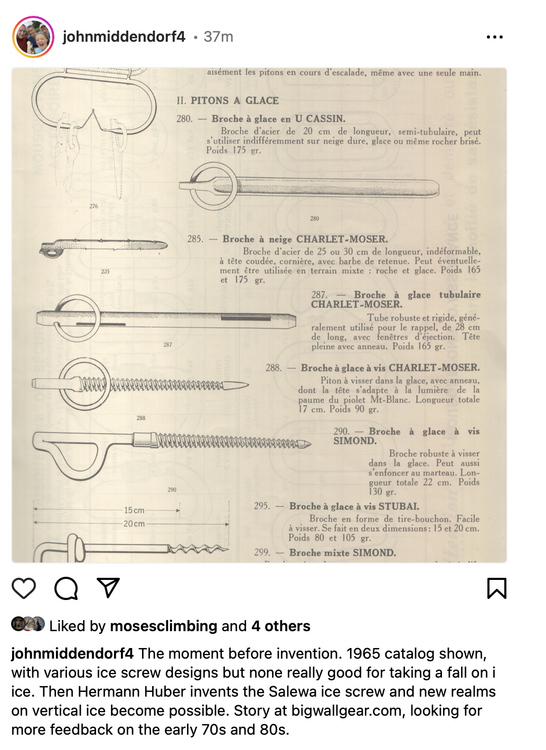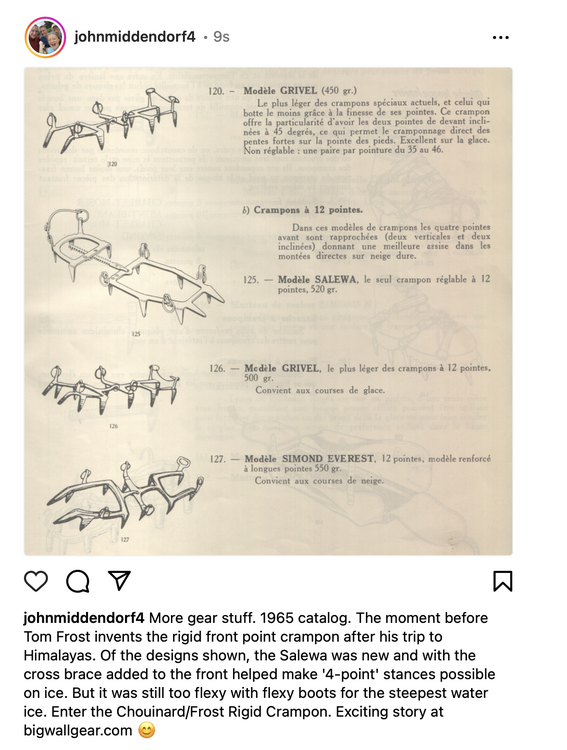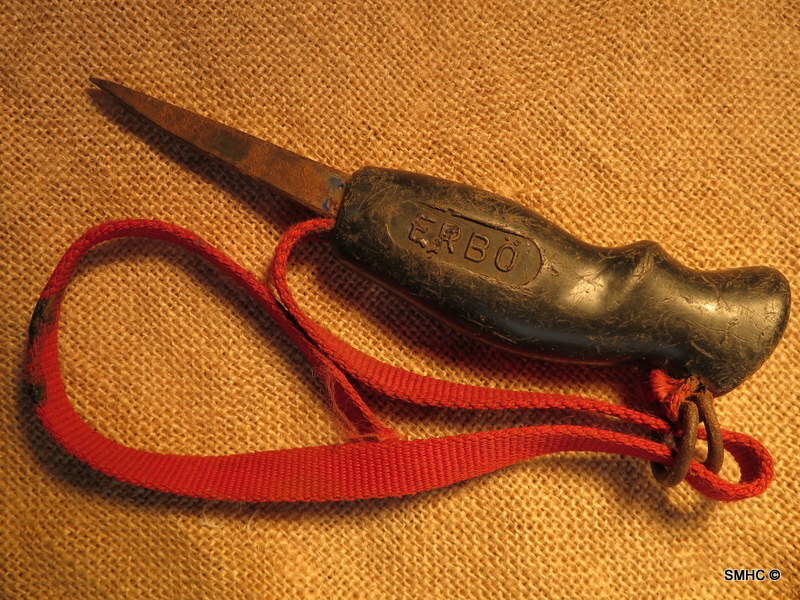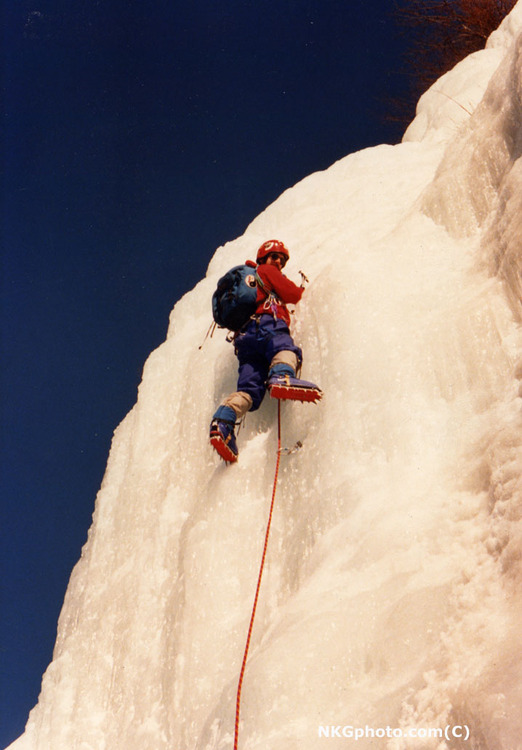Looking for feedback on ice climbing tools and techniques in 70s and 80s
|
|
I started ice climbing in the late 1970s on Mount Washington in New Hampshire, and the designs and availability of ice climbing equipment was quite varied, so often we made do with improvisations. I am sure there are a lot of other interesting tales involving the use of ice gear and experiments tried. Please share any stories here, or respond to my ice tool development article on Substack here: bigwallgear.com/p/ice-tool-… Would like to incorporate more of the regional invention that was happening a lot back then with small prototype tinkerers. Cheers and thanks. |
|
|
Great stuff as ever John John Cunningham experimented with daggers 'ice-bouldering' whilst working for the British Antarctic Survey in the mid 60s. He continued these experiments with fellow instructor Bill March when he worked at Glenmore Lodge at Aviemore in the Scottish highlands. The highpoint of dagger use was probably The Chancer on Hell's Lum (1969) which takes a series of short vertical icefalls. This was the shape of things to come. It was not trivial even with 1990s equipment as I found to my cost! If you've played with ice daggers - or a drive-in ice piton wielded by hand as some 1970s UK instruction manuals suggested - it is immediately obvious that stabbing them in and down at 40 or so degrees is far more secure than swinging them in nearly horizontally as you would an axe of that time. Cunningham and March modified their conventional axes, dropping the picks: "when nights in the staff wing were made hideous by mysterious comings and goings and the sound of hammering into the wee small hours. It was a time when everyone's favourite axe underwent a metamorphosis, first a softening by heat, then some bending and shaping to the required angle - followed by some tempering." John Cleare from here (secondary source). "The dagger and the hammer were thus combined as a single unit which provided the extra purchase required on long steep ice pitches". Cunningham and March describe new ice techniques in the 1972 (British) Alpine Journal. McInnes' Terrordactyl, the paradigm-shifting tool, appeared at the same time (prototypes in 1969). The Fox of Glencoe suggests the inspiration for the dropped pick was from sea anchors. I find it hard to imagine he hadn't also caught wind of what was going on on the other side of the hill in Glenmore Lodge. |
|
|
This is good input, Duncan, thanks! will be updating--hopefully I will post Volume 2 pdf soon.
This is a cross post (sorry), and the one on Trad climbing also has feedback for this topic. thanks all! |
|
|
When it came to learning technique in the 70's where would we have been without Gaston Rebufatte's Ice, Snow, and Rock. Not only did I commit to memory the pictures of his body language while moving on Ice I had to buy knickers, flashy socks, and a silly little wool cap. There was another classic tome by a British climber (Alan? somebody) that was maybe just "Mountaineering"? where I learned a lot of basic technique. "Freedom of the Hills" of course was a great resource. Then of course later cam Jeff Lowe's book "the Ice Experience" and Yvon's book "Climbing Ice" and we were enlightened as to how us Americans were changing the game. |
|
|
I started with Chounards book climbing ice. winter of 82 /83 I feel the Simond Chakals were the best tool of that era for steep ice .this shot probobly 85? it looks like I have a hummingbird in my right hand but almost certainly a chakal in my left. |
|
|
Nick Goldsmith wrote: Although John mentions the reverse-curve axe (with a Charlet Moser to represent it), I think he could perhaps better accentuate the effect reverse curve picks had on climbing. I remember the Simond Chacals as the first reverse curve tool appearing among those I climbed with in the early 1980s, along with the Forrest tools with a variety of picks. And then there's the evolution of shaft curves, perhaps starting with the C-M tools (at least in my bubble). And then there were the Hollywood stars (DMM Predator)! |
|
|
Norm: I think you are referring to: Alan Blackshaw, Mountaineering: From hill walking to alpine climbing, came out in 1965. Subsequent editions in 1968 and 1970. Chapter on ice equipment has some cool illustrations of axes and a dagger, etc. |
|
|
Thanks PTR that was the book. That was a long time ago. |
|
|
Thanks to all for input and local knowledge sources! |
|
|
John, article looks good as far as it goes. I note some holes, though. Its hard for me to imagine the advancements made in the 1970s without reference to British ice ace Bill March. After establishing himself as one of Britain's leading steep ice / waterfall climbers, March emigrated first to Idaho, where he earned a graduate degree in Outdoor Education while working as Director of the Idaho State University Outdoor Program. (hauling his students up the Black Ice Couloir, and the Nose, among other "big" routes) After completing his studies at ISU, he moved north to teach at the university in Calgary, Alberta. He wrote extensively, publishing an early guidebook to the Icefields Parkway, and a short tome "Modern Ice Techniques" which was worth its weight in gold. March stood out for his teaching footwork on steep ice/waterfalls - insisting that crampons be "placed" rather than kicked hard into the ice. His footwork on ice was more like rock-climbing, and on delicate ice where kicking destroyed as many placements as it produced, I found March-style footwork to be reminiscent of "smearing" on rock. while Bill never enjoyed the publicity of a Chouinard or a Lowe, his proteges, guys like Ken Wylie, Jeff Nazarchuck, & Jeff Splittgerber, provide ample illustration of March's impact on steep ice climbing in the '70s & 'eighties. -Haireball |
|
|
Hi Curt, Good point, I have included a bit on Bill March in my PDF compilation of my work, which are now available on bigwalls.net. It is not meant to be a comprehensive ice gear history, but the rough outline of how ice tools progressed as aligned with my rock tool research. Hope you can check it out (end of Volume 2). |

 Continue with onX Maps
Continue with onX Maps Sign in with Facebook
Sign in with Facebook
























